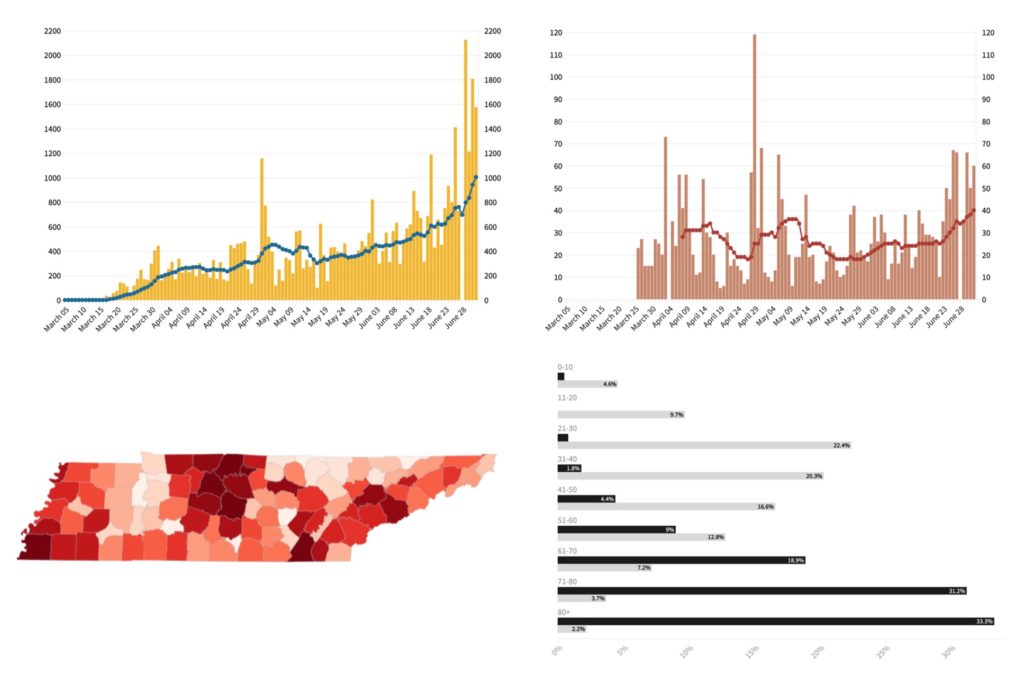
Updated at 5:45 p.m. on July 10.
Now in Week 18 of the coronavirus pandemic in Tennessee, it might be easy to think things are back to normal.
Restaurants and businesses have reopened. Special rules, in many places, have expired, though more counties are mandating masks.
But, the numbers show how far from normal the situation remains.
Tennessee’s total cases continue to rise — to more than 57,000 as of Friday. That means, in the last seven days, Tennessee has added 11,000 new cases, a number that took two months to reach at the start of the pandemic.
While any transferrable disease will accumulate cases over time, a clearer and more timely picture emerges when viewing how the state is reporting those daily increases in cases.
A real rise in new cases began in late April and see-sawed through May before what became an accelerating increase in June. At the start of the month, the average for newly reported cases in Tennessee was 396 per day. By the end of the month, the figure had more than doubled to 834 on average. As of Friday, 10 days into July, the rate has grown to 1,436 new cases per day — tripling the average from June 10.
The same goes for “active” cases, which also doubled in June to nearly 16,000. “Active” reflects a snapshot of those with the coronavirus who are considered currently contagious. As of Friday, the number of active cases in the state has never been higher, at nearly 25,000.
And simply put, this isn’t just a case of more testing finding more cases. Although testing has also roughly doubled, so has the positivity rate — to 8%.
So, how did we get here?
Spread And Hot Spots
Tennessee’s first case of the coronavirus was confirmed on March 5 in Williamson County, just two days after deadly tornadoes tore through Middle Tennessee. In less than three months, the virus reached every corner of the state — with at least one case confirmed in all 95 counties by Week 11.
Reach doesn’t equate to intensity though. The last holdout in the state, Hancock County in East Tennessee, still has only 11 confirmed cases.
By comparison, the two worst hot spots in the state — Nashville and Memphis — have around 13,000 cases each.
Though Davidson and Shelby Counties are neck-and-neck in this race no one wants to win, Shelby makes up more than 75% of cases in West Tennessee. Davidson, on the other hand, makes up just 44% of Middle Tennessee cases.
That’s because Nashville is surrounded by other intensifying hot spots. Rutherford County has reported more than 3,000 cases, closely followed by Sumner, Williamson and Trousdale Counties — the latter of which saw a 1,300-person outbreak at the state’s largest prison.
Overall, Middle Tennessee makes up nearly half of the coronavirus cases statewide.
An Uptick In Truly Sick Patients
The severity of COVID-19 on an individual level is better gauged by the trend in hospitalizations. There are now more COVID-19 patients in Tennessee hospitals than at any prior time during the pandemic — although state health officials say they still make up just 5% of patients, and that bed capacity is generally stable.
The number of new hospitalizations climbed in June, but not at the same rate as the new cases statewide. Vanderbilt University epidemiologists think that may be because young people were making up a larger share of cases.
The proportion of those who tested positive who are then hospitalized has actually decreased from 8% to 6% in the last month. And with that downturn in severity, the fatality rate for the virus has ticked back down to 1% — a rate not seen since the first week of April.
Yet, in the last month, almost as many people died in Tennessee from the coronavirus as in the three months preceding June. By the end of May, 364 Tennesseans had died. As of Friday, the death toll was 723.
And, as the sheer volume of cases continues to rise, so do newly reported deaths. The average at the start of June was five new deaths reported a day. A month later, the daily average has doubled to 10.
Age And Race Disparities
Of those, the elderly make up a disproportionate share of deaths (black bars) compared to their small share of overall cases (gray bars).
Public health officials have long warned that elderly people are more vulnerable to the coronavirus. Officials have been warning those over the age of 65 to take extra precautions since the start of the pandemic. In Nashville, 10% of residents over 65 who contract the coronavirus have been dying.
Statewide, those over the age of 60 make up just 13% of cases and 82% of Tennessee’s deaths.
Meanwhile, residents in their 20s account for roughly a quarter of total cases and make up just 1% of deaths.
Disparities can also be found when you look at the race and ethnicity of Tennessee’s sick.
Black people make up at least 20% of cases, though they are 17% of the general population, according to U.S. Census data. We can only say “at least” because 16% of cases are bi-racial or multi-racial individuals, so it could be significantly more people who identify as Black.
And, Latinos account for an even more disproportionate share of cases — with 1 in 4 of the sick being someone Hispanic, compared to the 6% of the general population Latinos make up.

